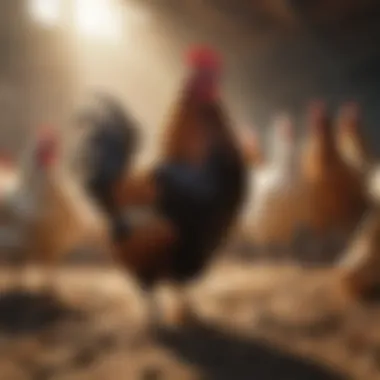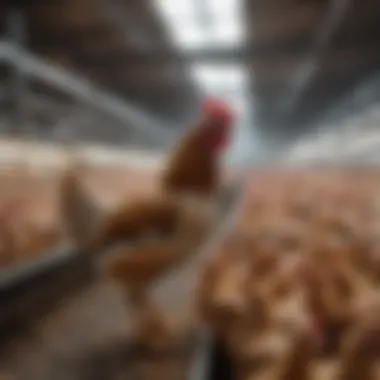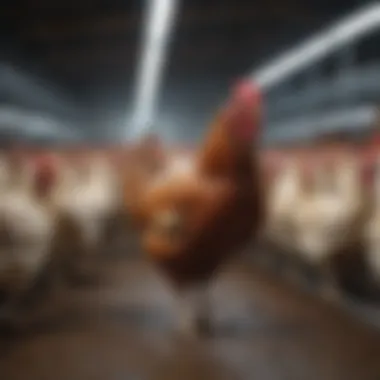Comprehensive Overview of Commercial Poultry Farming


Intro
Commercial poultry farming plays a vital role in the agricultural sector. It involves the production and management of poultry for eggs and meat. Poultry farming is not just a common practice; it is an essential component of food security and economic prosperity in many regions. The industry includes various types of poultry, such as chickens, turkeys, ducks, and geese, each requiring unique care and management practices.
Understanding the complexities of this industry is crucial for both agricultural professionals and enthusiasts. This overview focuses on key concepts, current trends, practical applications, and challenges in commercial poultry farming.
Key Concepts and Terminology
Definition of Terms
When discussing commercial poultry farming, it is necessary to comprehend some fundamental terminology. Here are essential terms:
- Broilers: Chickens raised specifically for meat production.
- Layers: Chickens bred to produce eggs.
- Poultry production systems: The various methods used in raising birds, such as free-range, cage systems, and organic farming.
- Biosecurity: Measures taken to protect poultry from diseases and ensure animal welfare.
Overview of Relevant Practices
Recognizing best practices in poultry farming can significantly impact productivity and sustainability. These practices include:
- Proper housing and environmental control
- Nutrition management tailored to species
- Routine veterinary care
- Effective waste management to maintain hygiene
Current Trends and Innovations
Latest Research and Developments
The poultry industry is evolving. Advances in breeding technology and genetics have led to birds that grow faster and are more disease-resistant. Research into vaccines and treatments is also expanding. This helps in maintaining a healthier flock which directly supports economic viability.
Emerging Technologies and Tools
Technological innovations offer potential improvements in poultry management. For instance:
- Automated feeding systems can ensure optimal nutrition levels at all times.
- Environmental sensors assist in maintaining the ideal living conditions to maximize production.
- Data analytics tools help in monitoring health and productivity metrics efficiently.
Practical Applications
Step-by-Step Guides
Establishing a successful poultry operation requires a structured approach. Here are key steps to consider:
- Assess market demand to identify which poultry products are in need.
- Choose the poultry species that fit your resources and market.
- Design the facility taking into account biosecurity and comfort for the birds.
- Implement a nutritional plan based on research for the selected species.
- Regularly monitor health and production metrics to adjust practices as needed.
Troubleshooting Common Issues
Challenges arise in poultry farming. Common issues include disease outbreaks and nutritional deficiencies. To mitigate these:
- Establish a strong biosecurity protocol to prevent disease introduction.
- Work with a qualified veterinarian to develop a health management plan.
- Ensure that feeding strategies meet the specific needs of different poultry types to prevent deficiencies.
"The future of poultry farming hinges on how effectively it adapts to innovation and sustainability practices."
Understanding the intricacies of commercial poultry farming will provide agricultural professionals and enthusiasts with the knowledge needed to navigate this essential field.
Prelude to Commercial Poultry Farming
Commercial poultry farming plays a pivotal role in the agricultural sector, providing a significant source of protein through meat and eggs. This form of farming addresses the growing demand for poultry products by utilizing advanced methods that enhance productivity and efficiency. The significance of this sector extends beyond mere food production; it provides employment opportunities, contributes to the economy, and promotes food security in many regions around the world.
Definition and Scope
Commercial poultry farming refers to the breeding and raising of birds, typically chickens, turkeys, ducks, or geese, for the purpose of producing meat or eggs on a large scale. The scope of this practice encompasses various types of operations, including broiler farms, layer farms, and breeder operations. This sector utilizes specialized breeding techniques, nutritional regimens, and health management practices to optimize growth rates and ensure the health of the birds.
The definition also includes a range of farming systems, from intensive to extensive methods, allowing for flexibility based on environmental conditions, market demand, and consumer preferences. The industry's focus on animal welfare, sustainability, and biosecurity measures reflects the evolving standards in food production, ensuring that poultry farming meets modern ethical concerns.
Historical Development


The history of commercial poultry farming traces back several centuries, but it began to take its modern shape in the early 20th century. Before then, poultry was generally raised on a small scale, primarily for subsistence. The introduction of industrial farming techniques revolutionized the industry, leading to increased reliance on intensive management practices.
In the 1950s, the use of hybrid breeds began to gain acceptance, resulting in marked improvements in meat and egg production. The advancements in genetics, nutrition, and veterinary medicine throughout the decades have played vital roles in enhancing productivity.
Today, commercial poultry farming is characterized by large-scale operations, often utilizing technology to monitor and manage the health and productivity of the flocks. This evolution reflects changing consumer preferences and the need for efficiency in food production. As society becomes more health-conscious, poultry farming continues to adapt, ensuring that it meets the demands of an evolving market.
Types of Poultry Farming
Understanding the types of poultry farming is essential for grasping the broader landscape of commercial poultry operations. Each type caters to different market needs and consumer preferences, influencing production methods and management strategies. This section explores these variations, highlighting their significance, benefits, and key considerations.
Broiler Production
Broiler production focuses on raising chickens specifically for meat. These birds are bred to rapidly gain weight, reaching market size in a relatively short period. The typical production cycle lasts about six to eight weeks. This system has gained substantial popularity due to its ability to meet the growing demand for chicken meat globally.
- Market Demand: Broilers are highly desirable in the food industry. Rapid growth rates help producers meet market needs effectively.
- Efficiency: This poultry production type utilizes feed conversion ratios to maximize growth while minimizing costs. The feed efficiency is crucial, as lower investment translates to higher profits.
- Management Practices: Effective management is vital. This includes biosecurity, nutritional requirements, and housing to ensure optimal growth and health.
Broiler farming stands as a cornerstone of the poultry industry, directly linked to meeting consumer needs and generating economic returns.
Layer Production
Layer production involves raising hens for egg production. Different from broilers, layers are bred specifically for their ability to produce eggs consistently.
- Egg-Laying Cycle: A healthy layer can produce around 250 to 300 eggs per year, depending on genetics and management. Understanding this cycle is essential for planning production schedules.
- Housing Requirements: Layer hens require adequate space, a consistent temperature, and proper lighting to optimize egg production.
- Nutritional Needs: Specialized diets are necessary. Layers need balanced nutrition to produce high-quality eggs, leading to increased profitability and marketability.
Layer farming plays a crucial role in the food supply chain, providing a stable source of nutrition for many consumers worldwide.
Breeder Farms
Breeder farms serve as the foundation for both broiler and layer production, focusing on raising parent stock to produce hatching eggs. These farms are about ensuring genetic quality and consistency in future production.
- Genetic Selection: The success of breeder farms hinges on the selection of genetic traits that contribute to growth rates or egg production.
- Reproductive Management: Effective management of breeding stock is essential to minimize stress and optimize production.
- Health Monitoring: Continuous health monitoring helps prevent disease outbreaks, ensuring the viability of future generations.
Breeder farms are often the unsung heroes of poultry production. Their work directly affects the quality and efficiency of meat and egg production.
Free-Range vs. Conventional Systems
The choice between free-range and conventional systems represents a significant ethical consideration in poultry farming. Each system has its advantages and challenges.
Free-Range Systems
- Animal Welfare: These systems allow birds to roam freely outdoors, promoting natural behaviors and contributing to better animal welfare.
- Market Appeal: Free-range poultry often commands higher prices in the market due to growing consumer preference for humane treatment of animals.
Conventional Systems
- Efficiency: Higher density housing can lead to lower production costs and greater control over environmental conditions. This system maximizes space and resources.
- Production Scale: Conventional methods enable larger scale operations, responding to the substantial global demand effectively.
Choosing between free-range and conventional systems often comes down to market demands and individual philosophy about animal welfare.
"The type of poultry farming system chosen can significantly impact both economics and animal welfare, showcasing the dual focus required in modern agriculture."
Understanding the various types of poultry farming provides insights into the complexities of the industry. Each type serves specific market demands and consumer preferences while ensuring the efficiency and sustainability of operations.
Management Practices in Poultry Farming
Effective management practices are essential for the success of poultry farming. They encompass a range of areas from housing to feeding, breeding, and record keeping. Each element plays a pivotal role in ensuring the health of the birds and ultimately, the profitability of the farming operation. When management practices are implemented thoughtfully, they contribute significantly to the overall productivity and sustainability of poultry farms.
Housing and Environment
The housing of poultry is a critical factor in their health and productivity. Proper housing systems protect birds from extreme weather and predators while providing adequate space for movement. A well-designed poultry house also aids in waste management and biosecurity. There are different types of housing, like conventional cages and modern aviary systems. The choice of housing greatly impacts welfare indicators such as stress levels, mortality rates, and egg production.
Temperature, humidity, and ventilation in the housing should be monitored to maintain optimal living conditions. Poor environmental conditions can lead to respiratory problems and other health issues.
Nutrition and Feeding Strategies


Nutrition is another essential aspect of poultry management. A balanced diet enhances growth rates, egg production, and overall health. Poultry feed should contain the right ratio of protein, carbohydrates, fats, vitamins, and minerals. This is crucial whether raising broilers or layers.
Feeding strategies may vary based on age, breed, and purpose. For instance, broilers require high-protein diets to promote rapid growth. Meanwhile, layers need specific nutrients that support egg production. Regular monitoring of feed quality and accuracy in ration formulation are vital.
Breeding and Genetics
Breeding practices and genetics impact productivity directly. Choosing the right breeds for specific farming goals—be it for meat or egg production—is essential. Advances in genetic selection allow farmers to optimize traits such as growth rate, feed efficiency, and disease resistance.
It is important to maintain breeding records. This ensures that any genetic selection programs are informed by historical data, resulting in better overall flock performance. Farmers should also consider cross-breeding strategies to enhance specific characteristics in their poultry.
Record Keeping and Data Management
Accurate record keeping is critical for efficient management. This includes tracking production metrics, health records, and feed usage. Good data management systems help in identifying trends and areas needing improvement. They facilitate compliance with regulations and standards as well.
Using software for data analysis can greatly enhance decision-making processes. Simple spreadsheets may be used, but dedicated poultry management software offers more robust tools for record management and reporting.
Keeping thorough records not only boosts productivity but also safeguards against potential liabilities.
Health and Biosecurity in Poultry Farming
Health and biosecurity are fundamental components of commercial poultry farming. They help protect both the livestock and the overall success of the farm. In poultry systems, diseases can spread quickly due to high stocking densities, leading to reduced productivity and significant financial losses. Therefore, implementing robust health measures is non-negotiable for any poultry operation.
Efficient biosecurity practices are designed to prevent the introduction and spread of diseases within flocks. These measures enhance poultry health and ensure food safety for consumers. It is critical to understand that even minor lapses in biosecurity can have long-lasting implications for poultry health.
Common Diseases and Disorders
Poultry farming faces various diseases that can affect bird health and farm productivity. Common ailments include avian influenza, Newcastle disease, and coccidiosis. Each of these diseases has distinct transmission paths and symptoms.
- Avian Influenza: This viral infection can exhibit severe respiratory signs and is highly contagious. It may lead to significant mortality within a flock.
- Newcastle Disease: Caused by a virus, it affects respiratory, nervous, and gastrointestinal systems. The disease is also highly contagious.
- Coccidiosis: This parasitic infection is common in young birds. It leads to intestinal distress and can hinder growth and feed efficiency.
Furthermore, proper diagnosis and understanding of these diseases are essential. Regular veterinary checks and flock monitoring should be a consistent practice on any poultry farm.
Vaccination Protocols
Vaccination plays a pivotal role in preventing diseases within poultry flocks. Proper vaccination protocols depend on the species of birds and their exposure risk to pathogens. Developing a vaccination schedule should involve the following steps:
- Identify Diseases: Determine the main diseases the flock is at risk for based on region and history.
- Select Vaccines: Use vaccines proven effective for the identified diseases. Vaccines like those for Marek's disease and infectious bursal disease can save flocks from significant losses.
- Administer Vaccines: Follow guidelines for administering the vaccines, ensuring correct dosages and timing. Timing of vaccination is critical to achieving maximum efficacy.
- Record Keeping: Maintain accurate vaccination records for each bird and batch. This assists in tracking vaccine effectiveness and identifying potential health issues.
Biosecurity Measures
Implementing effective biosecurity measures is vital to prevent disease spread in poultry farms. Key biosecurity practices include:
- Control Access: Limit farm access to authorized personnel only. Visitors should undergo screening.
- Sanitation Protocols: Maintain cleaning and disinfecting routines for equipment, vehicles, and clothing. Cleanliness can drastically reduce disease transmission.
- Quarantine New Birds: Isolate any new birds for a specific period to monitor for symptoms before introducing them to existing flocks.
- Monitoring and Reporting: Regularly monitor flock health and report unusual signs to a veterinarian immediately. Early detection is key to controlling outbreaks.
Biosecurity is more than a set of practices; it requires a commitment to maintain health within all aspects of poultry farming. Affected operations must prioritize health and biosecurity to sustain successful poultry production.
Economic Considerations in Poultry Farming
Economic considerations play a critical role in the viability and success of poultry farming. Understanding these aspects is essential for farmers and stakeholders in the agricultural sector. The economic landscape for poultry farming covers several important areas, such as market trends, production costs, and profitability. Each of these elements significantly influences decisions made by poultry farmers. Ultimately, grasping the economic aspects helps producers maximize benefits and ensure sustainability in their operations.
Market Trends and Pricing
Market trends in the poultry industry fluctuate due to various factors. Supply and demand, consumer preferences, and global trade policies significantly impact pricing strategies. For instance, the rise in demand for organic and free-range poultry has led to different pricing structures compared to conventional farming. Farmers must stay informed about these trends to effectively align their production methods and marketing strategies.
It is also important to monitor prices of feed, which constitute a substantial portion of production costs. When feed costs increase, this often translates into higher prices for poultry products. Conversely, decreased feed prices can lead to more competitive pricing in the market. Keeping an eye on current market trends is crucial for making informed pricing decisions.
Staying abreast of market trends is not just a strategy; it is a necessity for successful poultry farms.
Cost of Production Analysis
Conducting a comprehensive cost of production analysis allows poultry farmers to understand their expenditure patterns. This analysis includes operational costs, such as feed, housing, veterinary services, and labor. Each of these elements contributes directly to the overall financial health of a poultry operation.
Farmers must regularly evaluate their costs to identify any inefficiencies. For example, excess feed wastage can lead to increased costs. By optimizing feeding practices, farmers can reduce expenses and improve profit margins.


Moreover, maintenance of facilities is another critical cost consideration. Investing in durable housing and equipment can lower long-term costs. Thus, a well-thought-out cost structure creates a strong foundation for profitable operations.
Profitability and Financial Planning
Profitability is the ultimate goal for any poultry farming operation. To achieve this, effective financial planning is paramount. This involves forecasting income, analyzing costs, and creating budgets to manage expenses efficiently. One important financial aspect is the need to adopt appropriate pricing strategies based on market conditions.
Additionally, diversifying product offerings can enhance profitability. For instance, integrating value-added products, such as processed chicken or egg products, may open new revenue streams. The financial plan should also account for unexpected variables, such as disease outbreaks or price volatility.
In summary, understanding economic considerations helps poultry farmers navigate the intricate landscape of costs, pricing strategies, and profitability. Mastering these elements can lead to successful practices that ensure a thriving poultry farming business.
Sustainability and Ethical Practices
Sustainability and ethical practices in poultry farming are essential for maintaining the balance between productivity and environmental stewardship. As the global population grows, the demand for protein sources, especially poultry, continues to rise. However, increased production should not compromise the ecosystem or animal welfare. Understanding the significance of sustainability in poultry farming helps farmers adopt practices that meet both economic and environmental goals.
The importance of sustainability can be observed in various aspects of poultry farming:
- Resource Management: Sustainable practices help in conserving water and nutrients, minimizing waste. By optimizing the use of feeds and avoiding overuse of antibiotics, farms can operate more efficiently.
- Environmental Impact: Reducing greenhouse gas emissions and managing waste are critical. Sustainable poultry farms often implement renewable energy sources and efficient waste management systems, which lower their carbon footprint.
- Consumer Demand: Today's consumers are increasingly concerned about the origins of their food. They prefer products that are ethically sourced. Meeting these demands helps farmers tap into new market opportunities.
- Regulatory Compliance: Many regions now have regulations that promote sustainable agriculture. Adopting sustainable practices aids in compliance with these regulations, avoiding potential legal issues.
The following subsections delve deeper into specific sustainable farming practices and the standards pertaining to animal welfare.
Technological Innovations in Poultry Farming
The integration of technology in poultry farming has transformed traditional practices, enhancing efficiency and productivity. These innovations address many challenges faced by poultry farmers, including labor shortages, disease management, and production optimization. Understanding these technologies is crucial for advancing poultry farming practices.
Automation and Robotics
Automation is reshaping the poultry sector by streamlining operations. Tasks such as feeding, watering, and egg collection can now be performed by robotic systems. These machines reduce labor costs and improve precision in daily activities. For instance, automated egg collection systems help in reducing egg damage and ensuring clean storage. Farmers also benefit from time savings, allowing them to focus on other critical aspects of their operations.
Additionally, robotic systems can enhance biosecurity measures by reducing human contact with birds, which is vital for preventing disease outbreaks. The initial cost of implementing these systems can be high, but the long-term gains often outweigh these expenses.
Data Analytics and Monitoring
The use of data analytics is essential for effective poultry management. Advanced software helps in analyzing production data, tracking bird health, and optimizing feeding regimes. Sensors can monitor environmental conditions, such as temperature and humidity levels, ensuring that they remain within optimal ranges for poultry health.
Farmers can access real-time data, allowing for quicker decision-making and intervention when needed. For example, if data indicates a spike in temperature, farmers can implement cooling measures swiftly to protect the birds from heat stress. This proactive approach can significantly enhance bird welfare and productivity.
Disease Detection Technologies
Emerging technologies in disease detection are crucial for maintaining flock health. Various diagnostic tools now enable early identification of diseases, helping farmers to respond quickly. Rapid testing kits and advanced imaging technologies can detect diseases that may not be visible to the naked eye.
For instance, genetic testing can identify potential diseases before they affect the entire flock. Moreover, implementing monitoring systems that track disease outbreaks can facilitate swift action to prevent further spread, thus safeguarding the livelihoods of poultry farmers.
"The adoption of these innovative technologies is critical for ensuring the sustainability of poultry production in an ever-changing economic landscape."
In summary, the technological innovations in poultry farming play a vital role in elevating productivity and improving the overall health of the flock. As the industry continues to evolve, embracing these advancements is not just an option; it is essential for success.
Future Challenges in Poultry Farming
The poultry industry faces a myriad of challenges that influence its sustainability and productivity. Understanding these challenges is crucial for stakeholders, including farmers, policymakers, and consumers. These future challenges not only impact production capacity, but they also touch on health, economics, and ethical considerations. The resilience of the poultry sector hinges on its ability to adapt and innovate in response to these evolving difficulties.
Climate Change Impacts
Climate change presents a significant concern for commercial poultry farming. Rising temperatures, extreme weather conditions, and changing rainfall patterns can directly affect poultry health and production efficiency. Stress from heat can reduce feed intake and growth rates, leading to lower productivity.
In addition, climate-related changes can exacerbate existing health issues. For example, higher temperatures may increase the prevalence of diseases that thrive in warmer conditions. Farmers need to adopt adaptive strategies, such as improving housing conditions through better ventilation and housing designs, to mitigate these impacts. Environmental considerations also push towards utilizing more sustainable energy sources, as conventional practices often contribute to greenhouse gas emissions.
"The adaptation of poultry farming to climate change requires not only immediate actions but also long-term strategic planning."
Emerging Diseases
The threat of emerging diseases is another critical challenge in poultry farming. New pathogens can arise or existing pathogens can mutate, requiring constant vigilance and updated biosecurity measures. For instance, avian influenza remains a persistent threat, with outbreaks possibly leading to significant losses. Farmers must stay informed about disease trends and invest in biosecurity measures that limit exposure to pathogens.
Vaccination programs need continuous updating based on the latest research. Surveillance systems play a key role in early detection of potential disease outbreaks, thus enabling timely intervention. The financial implications of diseases can be profound. A proactive approach in monitoring and management not only preserves bird health but also ensures stability in production.
Global Market Changes
The dynamics of the global market are shifting due to various factors, including international trade policies, consumer preferences, and economic conditions. Changes in trade agreements can affect pricing and availability of poultry products, influencing local farmers' profitability. Moreover, there is an increasing demand for organic and ethically raised poultry, which compels farmers to adapt their production methods.
Understanding market trends is crucial for farmers. They should anticipate shifts towards sustainability and ethical sourcing to align with consumer expectations. Challenges such as fluctuating feed costs, driven by global supply chain issues, also affect production margins. To navigate these market changes, poultry producers must be flexible and innovative in their business models, embracing new technologies and marketing strategies that enhance product appeal.







